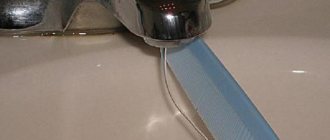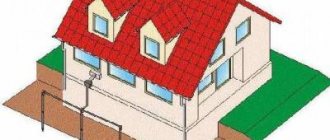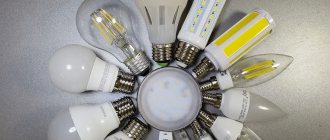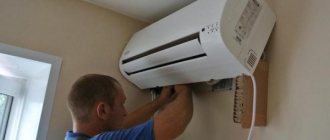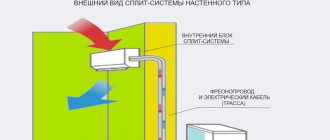You turned on the air conditioner as usual, the cooling process began, but after some time you discovered that water was dripping or even pouring from the indoor unit into the apartment. Liquid may flow:
- directly from the indoor unit to the room,
- through the blinds along with a flow of cooled air, as if the air conditioner is “splashing” or “spitting” water,
- along the wall on which the block is installed.
In this case, as a rule, the air conditioner does not flow immediately after switching on, but after some time - after 20-40 minutes. The intensity of the flood directly depends on the set cooling temperature: the greater the difference between the temperature in the room and the specified split system, the more abundant the water will flow.
Why does water flow from the split system indoors?
There are many reasons why the indoor unit of an air conditioner leaks. In this article we will look at them one by one, from frequent and simple to more rare. This will make it easier for you to find the problem and fix it yourself.
Causes:
- The drainage tray is full;
- Broken pipe;
- The drainage tube is clogged;
- The drain tube is not installed correctly;
- Evaporator frozen;
- Problems with the pump;
- The freon line is broken.
What can you do if the climate control device does not turn on?
If such methods do not bring a positive result, you will still have to seek help from the service center employees, since this may be a fairly serious breakdown, the elimination of which will require experience and special repair equipment.
It would also be a good idea to check the batteries in the remote control, since in hot weather they tend to run out much faster.
For what other reasons can climate control equipment fail? In some cases, ineffective operation of the air conditioner may be due to the presence of other electrical appliances nearby: stove, toaster, kettle, etc. And in this case, it is quite simple to eliminate independent repair of split systems - we eliminate such an unsafe neighborhood and allocate a separate power source for the climate control equipment.
Many models of modern split systems can independently eliminate the problem with drafts using a very useful function - auto-oscillation of the blinds. Being in a horizontal position, the blinds very quickly neutralize drafts, while maintaining a fresh breeze in the room that is pleasant to the body and safe for health.
To avoid all these minor malfunctions, you should promptly and competently carry out repairs and maintenance of split systems. And doing it yourself will not be difficult, since it is done very simply.
Dirt in the tray
Condensation accumulates in any indoor air conditioner unit. It falls into a special tray, from which it goes into a drainage tube. If moisture drips from the indoor unit, or the air conditioner generally spits water, the tray is most likely clogged.
Dust and dirt can get into the drain container, and if the split system is installed in the kitchen, grease. They gradually fill the spaces and there is no room left for water. If the air conditioner spits water, this is a sure sign that this is the cause.
Solution of the problem
You need to open the air conditioner cover and look at the condition of the tray. If there is a lot of dirt in it, take it out and clean it. Sometimes you will have to remove the front panel to do this, but this is not difficult - you will only need to unscrew a few screws.
If the tray cannot be reached (it is hidden behind a radiator or fan), then arm yourself with an old toothbrush and detergent. The main thing is to avoid dirt getting into the drain hole.
User errors that cause the air conditioner to leak
When choosing an air conditioner and its further operation, it is extremely important to follow the manufacturers’ recommendations on temperature conditions: both outdoors and indoors. Violation of operating standards leads to incorrect operation, freezing and leakage of both the internal and external units.
Case from practice! Application from a flower shop. The 7000 W air conditioner does not work: the external unit is covered in ice, water is dripping from the internal unit. The area of the room is small - 6 m2, fenced off. The temperature outside is about 0°C, indoors 20°C. No installation violations were found. What could be the reason? In the operating instructions we read: when cooling, the temperature outside should be 18 - 43 C, indoors 21 - 32 C. Thus, the cause of the problem is a violation of operating conditions, as well as the initially incorrect choice of a split system model for the client’s needs.
Broken or broken connections
There is usually a pipe between the drain hole of the tray and the drainage tube. Sometimes it can crack, break off or fly off the tubes. This is a flexible hose that is held on with clamps or latches.
Open the air conditioner cover and look on the right and left sides (depending on the installation option) at the condition of the pipe. If the problem is in it and it is from it that water flows, it needs to be changed.
Solution
Don't look for an original pipe - you'll just waste your money . At any plumbing store or market, buy one of the same diameter and secure it with ordinary plastic zip ties.
If the old pipe was secured with clamps, wrap them or the pipe itself with fum tape. Then put on a new one.
Air conditioner drain pipe in the indoor unit.
Why is condensation from air conditioners harmful and dangerous?
On a hot summer night, many heard water dripping. In a panel house, the air conditioner is installed according to a standard design. The main goal of most companies is profit, and the craftsmen are very conservatistic. This means that changes to the project will not be considered by the installer. Most people favor simplicity, and in the vast majority of cases conservatism is justified.
Wall split system
A typical project involves installing outdoor units strictly one above the other. The external unit of the equipment is protected from rain. There is a visor made of steel and plastic. The sound is heard from drops falling on it.
The loudness of the shot depends on the height separating the two outdoor air conditioner units installed in the neighbors' hallways, and the time depends on the accumulation of moisture in the apartment of the neighbor living on the floor above. The canopy for the outdoor unit of the air conditioner is not equipped with a soundproofing sheet and is not designed to allow condensation to get in (the windows are closed in the rain). As we said at the beginning, excess liquid should drain into the sewer. Plastic pipes are laid under the ventilated facade of the house for these purposes. But our high-rise buildings are not adapted in this regard.
In advertising of new buildings, the option (condensate drainage) is specified separately as an advantage of business-class buildings. Which suggests that the developer understands and is aware of the difficulty. Choosing an air conditioner will soon become easier. Actions come down to assessing a few parameters:
Pipe outlet for condensate drainage
- British Thermal Units need to be converted to Watts. The information that a certain amount is required for a certain area is incorrect. Much depends on the conditions, or more precisely, the wall’s resistance to heat loss. In general, follow a simple rule: as much energy is lost in winter, as much energy needs to be replenished in summer. And the value is proportional to the temperature difference. In winter, heat flows out into the street; in summer, on the contrary, it tends to break into the house. The thermal insulation properties of the wall do not change. You need to estimate what the outside temperature is in the summer; take the room temperature from SNiP from 18 to 22 degrees Celsius. Then calculate the difference. Let's say it is 25 degrees Celsius. After this, the power is directly proportional, based on the fact that the loss line passes at a constant, known angle. Let’s say in winter, at a temperature outside the window of -25, 2.5 kW of power was spent on heating. The room is +20. Consequently, the difference in temperature, street and room, was 45 degrees. The air conditioner should produce half as much cold. And this is 1.25 kW. This is not consumption, but British Thermal Units reduced to Watts. An important indicator – solar radiation – is omitted from the calculations. Many will have to take the outside temperature not of the air and in the shade, but to assess the condition of the illuminated side of the ceiling. The difference is significant.
- Installation options vary greatly from manufacturer to manufacturer. This mainly concerns the maximum length of communications and the height difference between the indoor and outdoor units. This fact is important when choosing installation locations for the outdoor and indoor units. It’s good if the outdoor unit is in the shade or on the northern wall of the building: the temperature is lower and the efficiency of the air conditioner increases. It is ideal to lower the equipment completely into the basement, where the air is cooler - we save electricity. The standard installation includes a specified length of communications. If the value is exceeded, freon will need to be refilled.
We have already discussed the types of refrigerant on the portal. Today R22 is in fashion, it is allowed in the country. In the West they are seriously concerned - due to leaks of this freon, ozone holes appear. We are inclined to trust this, but the cost of R410 air conditioners is steep. As for refueling, experts say: the price is the same. Polyester oil, which is highly hygroscopic, is expensive. Owners of air conditioners with R have to use it. The reasons lie in the operating pressure. Air conditioners with R22 operate at 16 atm, while R410 operating mode parameters are one and a half times higher. It is impossible to convert air conditioners from one type of freon to another.
Here are the three main parameters for choosing an air conditioner.
Shall we clean the pipes?
Often the cause of condensation leaking from the air conditioner is a clogged drain pipe. This can be easily determined by eye.
Turn off the air conditioner and open the lid. If there is not a lot of dirt in the tray and the pipe is in good condition, the water should go down the drain. If there is water standing in the container, it means the drainage is clogged. You need to “break through” the resulting traffic jam.
Getting rid of the blockage
To clean the drain tube, disconnect it from the container. Just don’t forget to place a bucket or basin, otherwise all the water from the tray will be on the floor and walls... To clean the drainage, you need a regular electrical cable. It should be soft enough that it can be bent with little effort.
Insert the end of the cable into the drain tube and push into it until you feel it hit something. Congratulations, you've found the traffic jam! Now it needs to be broken through. To do this, “knock” on the plug until the cable goes further. But that is not all!
Most likely, you only made a small hole in the clog. Pull out the wire completely and wrap the end with cloth. It is advisable to secure it with tape or tape. Soak the cloth in detergent and clean the drain tube thoroughly.
Valve operating principle
The operating principle is as follows:
- As long as the pressure in the boiler is lower than the pressure in the system, the valve plate is kept open due to the influence of water flow. When the pressure is equalized, the spring presses the valve against the body and shuts off the water.
- If the heating is turned on, the water temperature gradually increases. The pressure also increases proportionally. If it does not exceed the limit values, then nothing changes in the operation of the valve.
- As soon as the pressure reaches a threshold value, the spring of the safety valve is compressed under its influence. In this case, the exit to the fitting opens. A small amount of water from the unit is drained through the fitting. As soon as the pressure decreases, the spring closes the passage and the water no longer flows.
Video of safety valve device
https://youtube.com/watch?v=QaUgI_NjQvA
It becomes clear that the liquid from the fitting must be dripped up periodically. This happens when the pressure in the water supply system decreases and during water heating. Periodically appearing water at the fitting indicates normal operation of the device. To drain liquid, a flexible tube of suitable diameter is installed on the pipe and secured with a clamp. Without fastening, the tube will break off, because the normal pressure in the system is 6-10 bar. The other end of the tube is discharged into the sewer.
Installers with two left hands
Problems with condensate drainage may begin soon after installing the air conditioner. In 99% of cases this is due to unprofessional (in some cases drunk) installers.
The fact is that the drainage tube must slope downwards throughout its entire length. Sometimes, during installation, a hole is made in the wall that runs parallel to the ground, or even directed upwards. In this case, according to the law of gravity, moisture will not be able to flow out and will accumulate in the tray.
It is not difficult to identify the problem - just look at the places where the drainage enters and exits the wall.
Solution
There are two options - either punch a new hole, or hang the air conditioner higher. But the best thing is to call the installers. They simply must correct their mistake.
If you installed the air conditioner yourself, you will have to arm yourself with a hammer drill and choose. Naturally, it will be easier to punch a new hole. Its entrance should begin in the same place as the old one, but the channel should be directed downward.
Main causes of leakage
Sometimes owners of climate control equipment encounter problems that lead to malfunctions in the functioning of the indoor unit.
Overcrowding of the reservoir for collecting released moisture - this can happen if the equipment operates at maximum power for a long time. This happens in shopping malls and business centers, where air conditioners work non-stop.
Leaks are often preceded by attempts to reduce the cost of installing a system.
The hole was not made correctly - the fact is that it should be made at an angle, then the moisture flows out into the street, and not into the room.
The desire to save money on installation work results in even greater expenses for the owners of the premises: first they will have to pay for the illiterate installation of equipment, and then fix the problem. In some situations, you have to completely remove the equipment and then reattach it - this will cost an order of magnitude more.
Sometimes there is a leak from the outdoor unit. As a rule, this cannot be immediately noticed, since it is from it that water usually flows when the air conditioning system is working properly. At the same time, uncorrected defects can damage the entire air conditioner. Most often the reasons are:
- lack of freon;
- clogging of the evaporation mechanism;
- breakdown of the motion controller;
- radiator damage.
Arctic cold in the indoor unit
Sometimes the reason that water flows from the air conditioner may be ice on the evaporator. Open the outer panel of the indoor unit of the air conditioner and inspect the radiator. If there is ice on it, the cause has been found.
In this case, there is so much ice on the air conditioner evaporator that it even froze the filter.
Ice may appear for three reasons:
- The air conditioner is set to operating temperature too low;
- The room temperature is lower than the operating temperature than the air conditioner and the humidity is high;
- There is not enough freon in the line.
Your actions
Turn off the air conditioner and wait until the evaporator thaws. To speed up the process, you can blow it with a regular hair dryer. After this, increase the temperature and use the device.
If the leak appears again over time, the problem is most likely low freon pressure. You won’t be able to fix this yourself, call a professional. At the same time make sure that the repairman has checked the freon line for leaks and topped up the air conditioner.
The fact is that the refrigerant circulation system is closed. If the pressure drops in it, then it could be broken. But sometimes freon comes out through microcracks in pipes or fittings very slowly and it doesn’t always make sense to seal them.
How to understand that a breakdown has occurred?
First you need to determine where the leak came from.
There are three main locations.
- Directly from the indoor unit itself.
- Through the blinds of the split system, individual drops or large splashes enter with air flows.
- Water flows along the wall on which the indoor unit is located in the room.
Once you determine where the drop occurs, you can decide how to deal with it.
First, do a quick check. You should check the condensate tray; if the leak started during a hot period, when the air conditioner operates for a long time in cooling mode, then this is a completely normal situation. When the container is overfilled, the water will overflow and form a leak. To stop a flood, you just need to drain the water.
Drips are also often caused by dirt on the condensate tray. If it is not cleaned, the dirt can be compressed and form a blockage.
Inspection of the condensate tank during hot weather should be done every few days, since the equipment is working at its maximum capacity at this time, as well as before the onset of cold weather. If the dripping does not stop after this, then a serious equipment failure has probably occurred.
For exclusive owners
Sometimes water is drained using a special pump. This is usually done when it is not possible to lay drainage to the street. For example, if the room in which the air conditioner is installed is located below ground level - in the basement.
In this case, a small pump is placed on the drainage system, which pumps water out of it from time to time. Typical pump problems may include:
- The float chamber is clogged;
- The power contacts have come loose or oxidized;
- There is no contact between the sensor and the pump;
- The air vent tube is pinched, flown off or clogged;
- The pump itself burned out.
To find a solution to the problem, you need to check all the above points.
The main reasons for the appearance of water
Failure of the drainage system is the main reason for the appearance of water from the air conditioner. But there are others:
- Clogged filters. Water drips from the air conditioner directly into the apartment. The intensity of the leak depends on how hot the room is. If the filter elements are very dirty, the equipment may begin to suck air from the drain. Comprehensive filter cleaning is required.
- There is a blockage in the indoor unit (on the evaporator or fan). The evaporator helps to extract heat from the air and is located in the internal block of the split system. The fan is an important element of air conditioners. Available in both indoor and outdoor units. In the indoor unit, the fan provides forced air circulation through the heat exchanger (another element of the indoor unit). If dirt accumulates on the evaporator or fan, this impairs the heat transfer of the device and a snow cover forms. When melted, the cover turns into water, which forms outside the drainage system and flows out of the indoor unit. Pollution leads to deterioration in the performance of the air conditioner (the unit does not cool the room well). A comprehensive cleaning will correct the situation.
- Indoor unit fan failure. If a fan failure leads to a decrease in the rotation speed of the blades, ice forms, which melts and flows out of the indoor unit. To fix the problem, you will need to either repair or replace the fan.
- Lack of refrigerant. In the cooling system, a refrigerant leak (the working substance of the refrigeration machine) or its natural evaporation may occur. The problem is accompanied by the appearance of ice on the evaporator, which, when melted, will spray from the indoor unit of the air conditioner. If the device is equipped with a diagnostic system, an error message will appear on the screen: “refrigerant shortage”. Refilling the system with freon (special hydrocarbons used in refrigeration appliances as a refrigerant) will help restore evaporated refrigerant. If a leak is detected, the cooling system must first be sealed and then refilled.
- Clogged capillary system (in non-inverter equipment). The capillary tube is an important element of the refrigeration system. Its clogging is a common problem in this unit of air conditioning devices. A clogged tube leads to a deterioration in freon circulation. In this case, the evaporator is covered with snow, and there is ice on the elements of the external unit. The split system loses its ability to effectively cool the air (even if it operates continuously). The situation will be corrected by blowing out the capillary tube with special equipment (under pressure). In case of severe contamination, hydraulic cleaning with solvents is used. In some cases, the tube must be replaced with a new one.
- Malfunction of the thermostatic valve (in inverter air conditioners). The thermostatic valve acts as a capillary tube, but unlike it, it has adjustments. Violation of the settings or breakdown of the valve leads to a change in pressure inside the device and to boiling of the refrigerant. The air conditioner stops cooling properly, the evaporator and the thin tube of the external unit become covered with snow and ice. The expansion valve needs to be repaired or replaced.
- Failure of the temperature sensor (in those models in which it is provided). If the sensor fails, the temperature of the cooling element drops. If the drop is excessive, the indoor unit of the air conditioner freezes and water begins to flow out of it. In these cases, urgent replacement of the sensor is required.
- Failure of the control board (control module). When the control unit fails, the leak is sometimes accompanied by program failures. The air conditioner stops working effectively. The board needs to be repaired or replaced.
Freon evaporates in the wrong place
Inside the indoor unit there are copper tubes through which freon circulates. If a crack appears in them, it begins to evaporate. At the same time, its temperature can drop below -40 degrees.
At this temperature, moisture in the air crystallizes and settles on different parts of the indoor unit. Over time, it accumulates, heats up and begins to melt. In this case, drops of water fall past the tray and the air conditioner begins to flow.
It is difficult to determine this problem on your own, it is better not to risk it and call a specialist. If none of the solutions described helped you, contact a specialist. You can find it using a specialized service for selecting masters . He'll definitely figure it out.
Causes of leakage
The drainage is clogged and does not cope with the drainage of liquid to the outside:
insects, which are attracted by the coolness of the water during the hot period, get into the drainage pipe. They remain there, settling inside the block, preventing the normal outflow of condensate;
- the outlet hose becomes clogged with debris, dirt, dust, animal hair, which gets inside the split system along with the drawn-in air flow. Over time, the remaining dirt accumulates inside the outlet tube, condensed moisture collects in the pan, and then pours out over the edge;
- bacterial contamination of the tank, the entire drainage. If the necessary maintenance is not carried out properly, colonies of bacteria, mold, and mildew begin to multiply in the unit. Microorganisms accumulate inside the system, mucus forms, preventing natural outflow. In addition to the fact that this is dangerous for the health of apartment residents, negative external manifestations arise: an unpleasant odor, water leaking from the air conditioner;
incorrect placement of the outlet pipe during installation. The hose must be placed at a slope so that the moisture flows out on its own under the influence of gravity. If you place it horizontally, with bends, creases, etc., the condensate will not overcome the obstacles and will accumulate in the pan.
- the indoor unit is not installed strictly horizontally, as required by the installation instructions. Result: water flows from the air conditioner into the room;
- During installation, elements of the water drainage system were damaged;
- poor-quality flaring of copper pipes contributed to depressurization of the cooling circuit. Freon began to come out and ice began to form on the evaporator. When the ice cover melts, a volume of liquid is formed for which the split drainage is not designed.
Use of climate control equipment during the cold season at low temperatures. If the split system is not designed to operate in cold weather, and a winter heating kit is not installed, the water in the outlet pipe outside will freeze. The ice plug will prevent moisture from draining out.
Proper care - we extend the life of your own air conditioner
Many owners of split systems are looking for ways to avoid breakdowns, but competent and timely care and cleaning will be sufficient. High-quality equipment can serve well for many years, but if you do not monitor its condition and do not carry out fairly simple procedures, then the maximum that such careless owners can count on is 2-3 years.
The very first thing you should take care of when purchasing new climate control equipment is the most optimal place for its installation and the correct adjustment of the operating mode. Cooled air should be evenly distributed throughout the entire space, and not directed in a single stream to one point.
You should also periodically check the condition of the filter, which gets clogged from time to time and reduces the efficiency of the air conditioner. In order to correct this situation, you will need to remove the outer cover, remove the filter and rinse it thoroughly. And in this case, repairing the split system yourself is not difficult and will not take much time. Moreover, some models are already equipped with special indicators that allow you to find out about the condition of the filter and the degree of contamination. If it has not been cleaned for a long enough time, then it will not be possible to do without special solutions.
Another important nuance that should be taken care of in a timely manner is the refilling of equipment with freon, which plays the role of a coolant. Without this component, the air conditioner simply will not be able to function. And if the installation of the split system was not done well enough, then a freon leak may occur. As a preventative measure, it is recommended to refill the air conditioner with this coolant once every 1.5-2 years.
Suspicious noise
There can be several reasons why the air conditioner is humming. Perhaps this model is not designed for such increased loads, so the hum indicates wear on the compressor.
Also, if you do not clean the external unit from dirt in time, then dust and dirt will settle unevenly on it. This is especially true for fan blades. Due to contamination, they become unbalanced and prone to breakdown, so a constant hum is heard. You just need to clean the fan or replace it with a new one.
If you hear a clicking sound, this indicates a malfunction of the automation or internal parts.
Gurgling sounds indicate that air has entered the drainage system and condensate is not draining.
The solution is to straighten the tube at the desired angle to free the system from air.
Sometimes a hum occurs due to poorly secured parts. It is necessary to tighten all parts, fasteners and connections more tightly.
Cheap installation costs more
Also, the reason that water runs in an apartment or in a room, and not on the street, may simply be poor quality, but also inexpensive installation. The following factors are often highlighted:
- The hole was quickly drilled straight, and not at a slight angle, as expected (then the water naturally flows outside, and not into the room).
- The drainage tube may become broken due to the use of low-quality materials or simply working in a hurry.
- Poor-quality rolling, which caused freon to leak and, as mentioned above, the heat exchanger froze. As a result, melted water flows and ice falls out when the air conditioner is turned off.
- The freon pipe is poorly insulated. Because of this, condensation collects and begins to leak.
So cheap installation is more expensive, because the customer will pay first for poor-quality installation, and then for eliminating its consequences. And in many cases, the installation has to be started all over again, and as a result the client will pay two or even three times more! Conclusion - trust the installation of the air conditioner only to specialists from reliable companies to avoid the above problems.
So we looked at the main reasons why the air conditioner in the room leaks, as well as ways to fix the problem yourself. We hope now you know why water starts to drip and what to do in this case!
It will be interesting to read:
- Low voltage in the network - what to do
- The best air conditioner manufacturers
- How to install a fan in the bathroom


